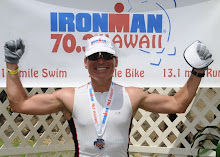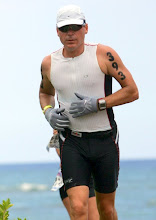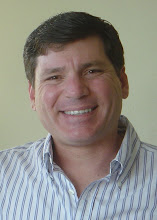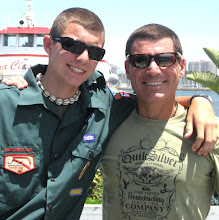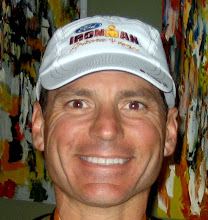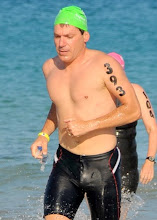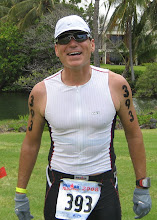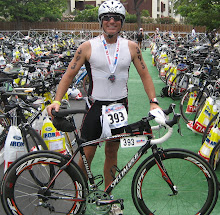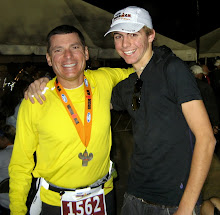
I slept pretty well the night before, despite getting up at 2:00 am for a meal (you need about 3 – 4 hours for the meal to digest pre-race) and then got up at 4:00 am to head over to Tempe Town Center.
It was totally dark, but out of nowhere, my great friend Kelvin Shields shows up to surprise us. Having Kelvin there was fantastic because he knows the ropes of Ironman.
Kelvin once served an internship with Ironman organization during the late – 90s and he knows how these things operate. Having him there was exactly like having a best man at a wedding. He took care of all the details so that I could focus on getting ready and getting focused. I cannot overstate how important it is to have someone like that to assist on race morning. I never would have understood the importance of this without Kelvin there, but let me assure you, if you ever want to attempt this endeavor, do yourself a huge favor and have someone assist you in these early morning hours.
Kelvin arrived at the venue even before I did. He used that time to scout-out the drop off points and more importantly, to learn the lay of the land for number markings and other early morning, pre-race essentials.
It was VERY cold in the morning and people were shivering. It was incomprehensible that in just about an hour or so, I would be in that freezing water fighting it out with over 2,000 other very nervous athletes for 2.4 miles.
Kelvin helped me with the wetsuit to make sure that we used a lot of Body Glide lubricant in the back of the neck where it can rub your skin raw due to turning your head to breathe on every other stroke.
My plan was to be the LAST person to jump into the water. The reason for this is that as 2,200 other athletes all jumped it, it would force us toward the middle of the lake, and my plan was to be on the far inside lane. In order to do that, I thought I should enter last. Then I would swim the 200 yards or so up to the starting line.
Despite my detailed plan, I did not count on the fact that so many people would actually force me to the very end of the pack. What that means is that once the cannon went off, I still had to swim nearly 200 yards just to get to the starting line! Whoops! That was not a good idea after all.
The swim was a mess. It was extremely hard to make any kind of forward progress with so many people clawing and scratching and bumping. For the first 5 – 12 minutes, many of us were barely just treading water waiting for the pack to open up and give us enough room to actually stretch our entire body out lengthwise so that we could actually swim.
I can keep a really good, straight line due to the fact that I have spent a year now in my Endless pool practicing swimming with my eyes closed to see if I can hold a line. Regrettably, most people cannot swim a line, so what happens is that I will be going straight, and then out of no where I would get T-Boned by someone swimming wildly off course. At one point, I got so tired of this that I started swimming with my head out of the water looking for open lanes to swim into.
That’s when disaster struck. At about the 1.75 mile point, I got T-boned, lifted my head to find an opening and immediately started a very quick and aggressive stroke at a very fast pace. That’s when my right leg cramped up severely from the combination of very cold water and the rapid acceleration.
The cramp was extremely painful and could not be controlled. I had no option but to stop and immediately grab that calf muscle. It was seizing up rapidly and then caused another cramp in my arch. I could not move; I was totally immobilized and people were swimming all over me. I tried to swim with the left leg only and then that leg cramped at the same time. I started to sink but the buoyancy of my full wetsuit prevented me from going completely under.
Here is the picture: I needed both hands to grab the cramping muscles that were seizing and causing unbearable pain, but as I grabbed the muscles, I would sink because I could not use my legs at all since they were all cramped-up. If I took my hands off the muscles to try and paddle and keep myself afloat, the muscles would immediately seize-up again!
Any movement of the legs would re-trigger the cramping.
I finally got to the point where I just sort of dragged my legs behind me, motionless. And finally in about 3 - 4 minutes, I was able to get the pain to subside. As a side note, the pain was so bad and the cramping so intense, that three days post race, I am still walking with a limp due 100% to a cramp in the left calf muscle. It is actually a pulled muscle that has microscopic rips and tears just from that aggressive and uncontrollable cramping!
The next problem with the swim was that the water was so incredibly cold that the two swim caps that I was wearing were not enough. I had “brain freeze” for about 20 minutes and the pain was like a migraine headache. I thought my race was over at this point. I literally thought I should just swim to the side and get out. I lifted my head to see how much further and was totally demoralized when I saw how far away that bridge was! But I just kept thinking about an emergency Imitrex pill I had stashed away in one of my special needs bags...or was it my bike jersey? If I could just make it to either one of those, I might be OK.
When I got to the end of the swim I had to climb up about 15 steps of a ladder/walkway out of the concrete channel. My legs immediately seized up from the cramping, but after about 20 seconds of light stretching, I was OK to walk.
The great news is that once I got into the changing tent, the heat from all those bodies actually made my headache go away literally within one minute. I was going to be OK!
My transition time in the changing tent was much longer than my worst case scenario, and at the time, I could not have cared less. I was just out of the water and I was thankful just to be alive. As a side note, the night after the race I slept very poorly with bad dreams that I was drowning in the swim. It was really that close with all that cramping.
So 15 minutes in Transition and I was out on the bike.
The bike was pretty easy for me because we had a plan to avoid anything that might trigger a hip reaction. The hip problem was something that had been a long-recurring issue for the past 15 months and our biggest concern in planning for the race. We did not want to do anything that might trigger a problem, so we dialed-back my average watts to be far lower than anything I had ever done in training. Basically, I could do that ride as an easy afternoon joy ride, and that is exactly how I treated it.
I didn't care if people passed me and I didn't ever try to catch anyone. I just stuck to my plan. I was a little off my wattage numbers and perhaps could have gone faster, but I just did not want to risk it. My average HR for the bike was only about 122, which is very low.
Then at about 70 miles into the bike, I had another tough issue happen. I started to feel some tension and some aching on the left knee at the Iliotibial Band (The IT Band). The IT band is a ribbon-like band that extends from the outside of the thigh over the hip and knee, and is connected again just below the knee. The band helps to stabilize the outside of the knee during exercise and it moves from behind the femur to the front as you bend your knee in walking, climbing stairs, cycling, etc. The continual rubbing of the band over the outside of the knee area can cause the area to become inflamed and causes shooting pain.
This is an injury of which I am quite familiar. At the first sign of this trouble, I literally said to myself, “John this is going to be really ugly.”
You see, the only way to relieve IT pain is to immediately stop what you are doing. There is no other way. And the more you do once the pain starts, the worse it gets because every cycle rotation of the pedals and every step or stride in running only makes it WORSE. At that point I knew for certain that the pain and inflammation would only get worse throughout the day.
If I had completed an Ironman prior to this event, then this would have been the signal to immediately stop and drop out of the race; most do when this happens. But I did not to consider that option today; I may not finish before the deadline, but I wasn't ever going to quit.
So I did the only thing I could do with a goal of finishing; I dialed-back my power/watts to the minimal level that would still help me maintain about a 15 mph average which would give me about a 7-hour bike split and still leave me with at least 8 hours to walk the marathon.
I struggled through the bike and finished in just over 7 hours. The run was next and is usually a strong event for me. I enjoy running. It’s simple, pure and often just relaxing.
But not today.
I changed into my running clothes, put on my Garmin 305 GPS watch and attached my Nathan hydration belt that was pre-loaded with 4 hours worth of CarboPro 1200. I was off.
The race plan was to do 9:30 miles for the first six miles and no faster, no matter what. Regrettably, I was having a really tough time just with the 9:30 miles. And with every single stride the IT band was rubbing, rubbing, rubbing. It was getting worse by the minute.
Finally the pain became unbearable and the band had swollen to the point where it was causing my knee to lock-up and click. The swollen band was interfering with the free movement of the knee joint. I had to improvise. I needed ice to try and reduce the swelling, but there was no way to hold it onto the knee!
Just the day before, I purchased some compression socks at the vendor expo. These go over the calf muscles and are very tight. The theory behind compression socks is that they cause constriction which forces blood into the area to provide more oxygen to aid the muscle and to carry away waste products such as lactic acid. But since I wanted to wear my own socks for the run, I purchased a modified compression garment that just covers from the ankle to the bottom of the knee. These compression garments have been proven for decades in hospitals for post-op recovery and now are leading edge technology for endurance sports. I purchased the garments from 2XU.
I suddenly got the idea to pull the compression garment up over my knee! That would give me some support of that area! Not the intended use for the product, but improvisation was what I needed at this point. And it did work a little, but I was getting the feeling that it was just pressing the IT band even harder onto the outside of the knee, perhaps even making the situation worse!
Then I decided to take off the other compression sock and put them both onto the same knee, one right on top of the other. Then when I arrived at the aid stations every mile or so, I had them load ice right in-between the two compression garments!! They were so tight that they easily held the ice in place, and since the ice was sandwiched in the garments, I could just leave it there without concern for frostbite or other damage from direct contact with the skin.
The ice inside of the compression garment worked incredibly well and saved my race!!
There was no possible way that I could continue with my strong run as we had so carefully planned, but at least I could significantly reduce the IT band pain and hopefully get close to finishing before the deadline.
Other than the IT band issue, I really had no other problems on the run. Certainly under other conditions I would have run significantly faster, but I was happy just to be moving.
It got dark quickly and soon it was pitch black. Even though I was shuffling along, I was still passing hundreds of people during the run portion of this event; most of them were walking at that point.
When I was passing the walkers I felt sorry for some who were really very ill and suffering from severe GI problems. Some of these people were world class athletes, and most were in way better physical condition than me, but they were just having a horrible day. One poor chap in particular was thin as a rail and an obvious champion. He’d speed by me, then pull over to the side and throw up, then speed by me again, only to pop out of a Porta Toilet and this went on for 15 miles! He was in such agony, but he finished, and I was proud that he finished in front of me because he earned every bit of that. He was a real champion, a winner, a hero.
But there were others who I passed that were just walking and enjoying themselves, just chatting away. They knew that they’d finish sometime that day if they just kept walking. I did not have as much respect for that group as the guys who were really suffering but somehow finding the drive, the pure grit, to continue.
I said to myself, “You will never learn what you are truly made of by walking.” And that’s true. I could have limped in by walking, but I would not have learned as much about my drive and my ability to endure pain and my resourcefulness to improvise.
The last 10 – 13 miles I had tears streaming down my face from the pain of the IT band, but I was not going to walk it in the whole way. I certainly did walk though. I walked through the aid stations for water, pretzels and ice. LOTS of ice for my knee. The ice was enough to get the swelling down so that the knee would not lock up and that’s what I needed to finish.
From about mile 10 – mile 22, things were really a blur. I cannot believe that I was out on the run course for a full 5 hours. I really cannot even begin to comprehend how I did that. There’s no ego here, no heroics. I really don’t know what happened or how I did it. I did not black out or anything like that. I do remember the aid stations and certain aspects of the course, but I have no idea how I was able to go the distance. I feel like someone picked my up at mile 10 and then just dropped me off at mile 22!
Once I saw the mile 22 marker, I knew I would finish. My home course is a five mile loop around Cal State Long Beach. I can do that loop in my sleep, after a large dinner, after a couple of beers, basically anything. So when I saw that I only had five miles to go, I was very happy and I think that raw emotion got me through the balance of that race.
Then when I came down the finish chute, my son Connor jumped out and ran beside me. I kept telling him, “Connor, you cannot run beside me and pace me, I will get DQ’d!!” I literally pushed him away and told him to get out of the chute, I will get into trouble and they won’t let me qualify! But then I remembered that an athlete can have one family member under the age of 18 run along side of them at the finish.
What I didn’t know was that my great friend, Kelvin Shields, had made arrangements for Connor to run alongside me and that Connor had the approval and the markings to allow him to do so.
But despite my urgings to get out of the chute, Connor stayed right there with me the entire 200 yards or so and I am SO HAPPY that he did! I would have ALWAYS regretted it, if he had pulled out!
I suppose that I did not have my full wits about me when I kept telling him not to pace me. With only 200 yards to go, I don’t think anyone would have said that this was an unfair advantage, but at that time, nearly 14 hours into my race, apparently my thinking may not have been crystal clear.
As I finished I heard the announcer say what I had been planning and silently saying to myself on the toughest workout days over the last 15 months, “John Callos....YOU ARE AN IRONMAN!!”
WOW, that was fantastic!!
I collapsed into the arms of two volunteers who draped a Space Blanket over my shoulders, gave me a finisher’s medal and a T-shirt that I will proudly display at some point.
My wife, coach, son and Kelvin were quick to arrive. I was a bit light headed and sort of just collapsed to the ground with weakness. The weakness was the emotion leaving my body, not a musculature soreness or tiredness. It was the amazing release and realization that I had accomplished the toughest goal that I had ever set out to achieve. It was the realization that I had actually completed this race.
It is still hard to believe.
Several years ago I saw the Ironman in Kona and literally thought that those people were super-humans. That there was no possible way whatsoever that I could ever conceive of doing anything like that. Ever. No way.
But I was so inspired by the event that I entered a community triathlon that nearly killed me! I was literally the LAST person out of the water on the swim and I couldn’t walk for three days following the 3- mile run! I look back at that now and marvel at the transformation.
There was a heavy price to pay. A heavy toll. And while I have not yet been asked whether it was worth it or not, I think that it was.
Not for the actual bragging rights, which of course are substantial, but more so for what I have learned about myself and what I have become in this process.




 Shortly after the race, my family encouraged me to get something to eat. I wasn't really hungry and the last thing in the world I wanted was pizza, but I went into the finisher's food court to have a look.
Shortly after the race, my family encouraged me to get something to eat. I wasn't really hungry and the last thing in the world I wanted was pizza, but I went into the finisher's food court to have a look. I slept pretty well the night before, despite getting up at 2:00 am for a meal (you need about 3 – 4 hours for the meal to digest pre-race) and then got up at 4:00 am to head over to Tempe Town Center.
I slept pretty well the night before, despite getting up at 2:00 am for a meal (you need about 3 – 4 hours for the meal to digest pre-race) and then got up at 4:00 am to head over to Tempe Town Center.







